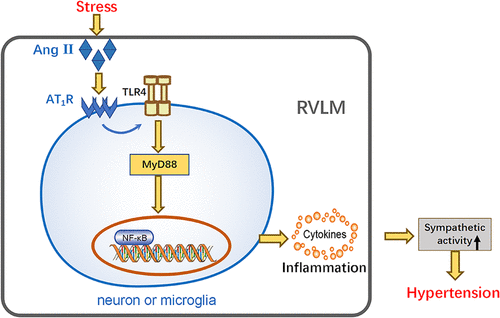当前位置:
X-MOL 学术
›
ACS Chem. Neurosci.
›
论文详情
Our official English website, www.x-mol.net, welcomes your feedback! (Note: you will need to create a separate account there.)
TLR4/MyD88/NF-κB Signaling in the Rostral Ventrolateral Medulla Is Involved in the Depressor Effect of Candesartan in Stress-Induced Hypertensive Rats.
ACS Chemical Neuroscience ( IF 5 ) Pub Date : 2020-09-08 , DOI: 10.1021/acschemneuro.0c00029 Hongyu Yang 1 , Xiaoshan Song 1 , Zhimiao Wei 1 , Chunmei Xia 1 , Jijiang Wang 1 , Linlin Shen 1 , Jin Wang 1
ACS Chemical Neuroscience ( IF 5 ) Pub Date : 2020-09-08 , DOI: 10.1021/acschemneuro.0c00029 Hongyu Yang 1 , Xiaoshan Song 1 , Zhimiao Wei 1 , Chunmei Xia 1 , Jijiang Wang 1 , Linlin Shen 1 , Jin Wang 1
Affiliation

|
This study aimed to investigate whether the proinflammatory and pressor effects of endogenous angiotensin II (AngII) are mediated by binding to the AngII type 1 receptor (AT1R) and subsequently activating central Toll-like receptor 4 (TLR4) in the rostral ventrolateral medulla (RVLM) of stress-induced hypertensive rats (SIHR). The stress-induced hypertension (SIH) model was established by random electric foot shocks combined with noise stimulation. Mean arterial pressure, heart rate, plasma norepinephrine, and RVLM AngII and TLR4 increased in a time-dependent manner in SIHR. Pro-inflammatory cytokines (tumor necrosis factor α (TNF-α), interleukin 1β (IL-1β)), myeloid differentiation factor 88 (MyD88), and nuclear factor (NF)-κB also increased, while anti-inflammatory cytokine IL-10 decreased in the RVLM of SIHR. These changes were attenuated by 14-day intracerebroventricular (ICV) infusion of VIPER (a TLR4 inhibitor) or candesartan (an AT1R antagonist). Both TLR4 and AT1R were expressed in the neurons and microglia in the RVLM of SIHR. Candesartan attenuated the expression of TLR4 in the RVLM of SIHR. This study demonstrated that endogenous AngII may activate AT1R to upregulate TLR4/MyD88/NF-κB signaling and subsequently trigger an inflammatory response in the RVLM of SIHR, which in turn enhanced sympathetic activity and increased blood pressure.
中文翻译:

延髓前侧延髓中的TLR4 / MyD88 /NF-κB信号参与坎地沙坦在应激性高血压大鼠中的降压作用。
这项研究旨在调查内源性血管紧张素II(AngII)的促炎和升压作用是否通过与AngII 1型受体(AT 1R),然后激活应激性高血压大鼠(SIHR)的延髓腹侧延髓(RVLM)中的中央Toll样受体4(TLR4)。通过随机的脚底电击和噪声刺激建立应激诱发的高血压(SIH)模型。在SIHR中,平均动脉压,心率,血浆去甲肾上腺素以及RVLM AngII和TLR4呈时间依赖性。促炎细胞因子(肿瘤坏死因子α(TNF-α),白介素1β(IL-1β)),髓样分化因子88(MyD88)和核因子(NF)-κB也增加,而抗炎细胞因子IL- SIHR的RVLM下降10。通过14天脑室(ICV)输注VIPER(TLR4抑制剂)或坎地沙坦(AT 1 R拮抗剂)可减轻这些变化。TLR4和AT1个R的在SIHR的RVLM神经元和小胶质细胞中表达。坎地沙坦减弱了SIHR RVLM中TLR4的表达。这项研究表明,内源性AngII可能激活AT 1 R以上调TLR4 / MyD88 /NF-κB信号传导,并随后触发SIHR RVLM中的炎症反应,进而增强交感神经活动和血压升高。
更新日期:2020-10-07
中文翻译:

延髓前侧延髓中的TLR4 / MyD88 /NF-κB信号参与坎地沙坦在应激性高血压大鼠中的降压作用。
这项研究旨在调查内源性血管紧张素II(AngII)的促炎和升压作用是否通过与AngII 1型受体(AT 1R),然后激活应激性高血压大鼠(SIHR)的延髓腹侧延髓(RVLM)中的中央Toll样受体4(TLR4)。通过随机的脚底电击和噪声刺激建立应激诱发的高血压(SIH)模型。在SIHR中,平均动脉压,心率,血浆去甲肾上腺素以及RVLM AngII和TLR4呈时间依赖性。促炎细胞因子(肿瘤坏死因子α(TNF-α),白介素1β(IL-1β)),髓样分化因子88(MyD88)和核因子(NF)-κB也增加,而抗炎细胞因子IL- SIHR的RVLM下降10。通过14天脑室(ICV)输注VIPER(TLR4抑制剂)或坎地沙坦(AT 1 R拮抗剂)可减轻这些变化。TLR4和AT1个R的在SIHR的RVLM神经元和小胶质细胞中表达。坎地沙坦减弱了SIHR RVLM中TLR4的表达。这项研究表明,内源性AngII可能激活AT 1 R以上调TLR4 / MyD88 /NF-κB信号传导,并随后触发SIHR RVLM中的炎症反应,进而增强交感神经活动和血压升高。



























 京公网安备 11010802027423号
京公网安备 11010802027423号